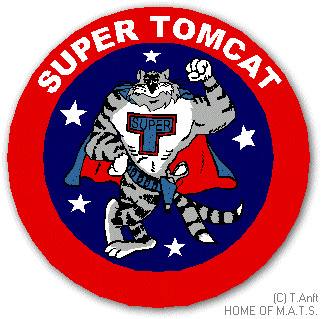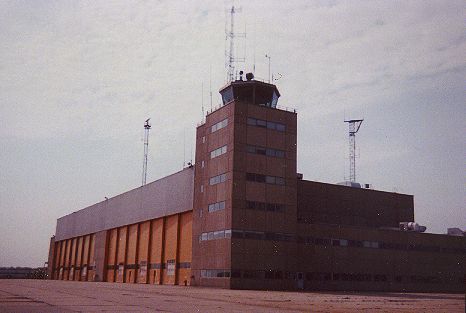
|
F-14D: The best ever! (Grumman Corp.)  In the late 1980s Grumman started a promotion for the new F-14D when the Navy was to
select their future carrier-based fighter. Since Grumman saw still a growing potential for the
F-14, they upgraded their 20 years old kitty with quite a range of up-to-date technology. But it
was no easy way for the F-14D to find its place in the Navy, a lot of setbacks on the political
scene made it hard and often endangered the F-14D production and remanufactoring. Finally, on
23 March 1990 the first production aircraft rolled off the assembly line. But sadly, the last one
followed only little more than two years later on 20 July 1992.
In the late 1980s Grumman started a promotion for the new F-14D when the Navy was to
select their future carrier-based fighter. Since Grumman saw still a growing potential for the
F-14, they upgraded their 20 years old kitty with quite a range of up-to-date technology. But it
was no easy way for the F-14D to find its place in the Navy, a lot of setbacks on the political
scene made it hard and often endangered the F-14D production and remanufactoring. Finally, on
23 March 1990 the first production aircraft rolled off the assembly line. But sadly, the last one
followed only little more than two years later on 20 July 1992.
The best visible modification are the engines. The F-14D is powered by two F110-GE-400 engines with 28,200 lbs thrust each. This increased thrust for the new Tomcat means no afterburners required for catapult launch on an aircraft carrier, improved "behind the boat" flying characteristics and more fuel efficiency. As pilots say, "the F-14D's new engines finally allow the pilot to fly the aircraft rather than the engines." The installation of the new GE engines required only minor changes to the aft fuselage and engine exhaust aera. Further improvements were:
 The F-14D met also the Navy's alert requirement that the aircraft
should be able to taxi with functioning systems within five minutes of a cold engine start:
The inertial navigation system and the rear cockpit display work within 3 minutes.
The F-14D met also the Navy's alert requirement that the aircraft
should be able to taxi with functioning systems within five minutes of a cold engine start:
The inertial navigation system and the rear cockpit display work within 3 minutes.
Furthermore, the F-14s strike capability was re-awakened. Since the first sketches on the drawing board the F-14 had a strike capability, but back in the early days there was no need for a "Bombcat". A-6s and A-7s did a good job and the Tomcat could fly as a pure air-superiority fighter with its unbeaten missile capabilities. Today, F-14A/B/Ds have full strike capability and gain even more competence in this business. LANTIRN equipped Tomcats deliver smart bombs as well as standard iron-bombs with a big bring-back capability. The Tomcat became even night-vision goggle capable and now it is an absolute long-range multi-mission day & night strike-fighter and reconnaissance platform. Wow! F-14D Rivals - But things went different for the latest Tomcat version, the F-14D, due to financial cut-backs and due to a pro F/A-18E/F lobby in the US government. The procurement number of new F-14Ds was reduced as well as the remanufacture numbers of aircraft that should have been upgraded from F-14A/B standard to the F-14D.
Finally it happened: A few days after the F-14D production and remanufacture were terminated on 26 February 1991, the US Department of Defense announced that the Navy wanted to develop a new version of the F/A-18 to replace both the F-14 strike-fighter and the aging A-6E. The F/A-18 is basically a light fighter and so it had to be dramatically modified to fit into the new multi-role. Such considerations were already made in 1984: These modifications included a two-man cockpit, upgraded APG-65 radar, enlarged wing-area for better landing performance, increased internal fuel-capacity (+ 3,000 lbs) and improved F404 engines with 18,000 lbs of thrust each. All these changes made the F/A-18E/F a new aircraft, but still the Navy was not satisfied since the Super Hornet did not have the internal volume to carry the avionics, sensors and countermeasures equipment to be well prepared for the future conflict environment. Further, even though the F/A-18E/F was somewhat faster than the A-6, the improved thrust could not compensate the gain in weight and therefore it would lose some of its agility! Even the Super Hornets range and payload suffered in comparison with the planned A-6F. And back in 1984 the Navy rejected the F/A-18E/F program... But the light fighter lobby was strong enough and today the F/A-18E and F are already flying instead of new F-14Ds rolling off the assembly lines... | |||
Top of the page |
F-14 Tomcat History: Photos of early testing and production | Export Tomcats | F-14B: The next step | F-14D: The best ever Grumman proposals for the future | Today & Tomorrow | F-14 Combat Records The last F-14 catshot | The Final F-14 Flight Event F-14 Tomcat: Other Topics: Start Page Foreword FAQ Updates Copyright © by Torsten Anft |
